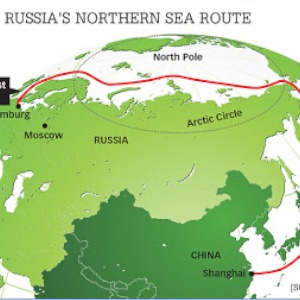Russia cheekily pushed the Northern Sea Route on Thursday as an “alternative” to Egypt’s Suez Canal after a huge container ship blocked the busy shipping lane. President Vladimir Putin has long promoted the passage along the country’s Siberian coast as a rival to the Suez Canal, and Russia seized on the Egyptian route’s traffic jam to play it up again. The Japanese-owned, Panama-flagged MV Ever Given got stuck Tuesday during a sandstorm, blocking the waterway that connects the Mediterranean with the Red Sea and which handles more than 10 percent of global maritime trade.
Russia’s nuclear agency Rosatom on Thursday gave three tongue-in-cheek reasons “to consider Northern Sea Route as a viable alternative to the Suez Canal Route”. The first reason, Rosatom said on its English-language Twitter account, was that the Arctic passage provides “way more space to draw peculiar pictures using your giant ships”. Rosatom included a link to a news article that reported that a tracking map showed the giant ship had made the shape of male genitals before becoming stuck. If ships get stuck in the Northern Sea Route, Russia would send ice-breakers to help dislodge them, said the nuclear agency, which is the passage’s official infrastructure operator.
Rosatom also posted an animated image from the “Austin Powers” series depicting its main character stuck in a shuttle car reversing back and forth in a narrow tunnel — photoshopped with the Panama-flagged vessel. “You might get stuck in the Suez Canal for days,” the nuclear agency said. A Dutch salvage firm that has sent experts to help move the Suez ship said Wednesday that recovering it could take days or weeks.
Russia has invested heavily in the development of the Northern Sea Route that allows ships to cut the journey to Asian ports by 15 days compared with the conventional route through the Suez Canal. As the route becomes increasingly free of ice due to climate change, Moscow is planning to use it to export oil and gas to overseas markets. On Thursday, Russia’s weather monitor said the route was “in some years almost completely free of ice” by the end of the summer, having reached a “record low level” of ice cover in 2020.







